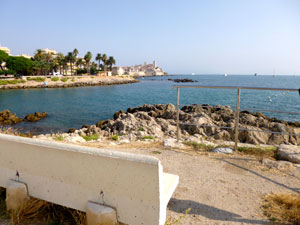
Last week I did something I’ve wanted to do all summer.
There’s a lone bench at the end of l’Ilette peninsula, a small piece of land that juts into the Mediterranean Sea near the end of Antibes’ old rampart walls. The bench faces the bay, looking out onto Old Town, and if you peer over your right shoulder when seated there, the Cap d’Antibes. Smack in the middle of that view of Cap d’Antibes is our home, Bellevue.
Below the bench on l’Ilette peninsula, the sea rolls onto a rocky outcrop that, at least this summer, is home to a wakeboarding shelter. At the base of the peninsula on the right side is the reasonably upscale Le Royal Beach restaurant.
But these things, you would say, are new additions.

The bench itself is basically two slabs of white cement. Behind it stands a tall shard of limestone with a plaque on it that has gone green, as copper does, with age. What I wanted to do all summer was quite simple: to read a particular book, or at least a section of that book, sitting on that particular bench stationed nearby that particular monument. So there I sat a short while ago, bicycle parked on my right, water bottle on the bench beside me, book in my lap.
Being the height of the August holidays, it was hot. The sun scorched down out of the late morning sky. As I tried to enjoy the experience I’d longed to savour, all I wanted to do was dive down to the Royal Beach restaurant and continue reading under the shade of an umbrella, drink in hand. But I could hardly do that. I was due to meet a friend there for lunch later. And anyway, more importantly, they’d suffered here on l’Ilette peninsula. There was no reason I shouldn’t do so, too.
I leafed through the book to remind myself of its context, squinting through my sunglasses as the sun bounced off its pages. Duel of Wits by Peter Churchill. That I’d even found the text was pretty amazing. I’d originally come across a summarized version in French, buried somewhere in the museum website of Nice’s Musée de la Résistance. The book had been translated from its original English, I later learned, under a wholly different title.

But last winter, as I sat in Toronto researching the details of life in Antibes more than a century ago, one thing led to another. Searching online, I found a secondhand copy of Duel of Wits at a community college somewhere in Indiana. It was pretty beaten up, I understood, but I bought it anyway, for $1.99 plus another $1.99 shipping. When the book arrived in Toronto, I packed it away for summer in France. I already knew the part of the story that interested me most, having read it online. I’d save the full story, in its original (and my original) English, for Antibes.
So there I sat in the mid-August sunshine, on a cement bench with a navy hardback book having the reference number 940.548 CH taped onto the base of its spine. Published in 1955, this copy was marked with stamps for the libraries of Scott Community College and Palmer Junior College. Flipping its pages brought forth a wholly familiar smell from my youth – that musty paper scent you find in old books, and especially in those sorts of books that have oodles of facts to impart to any chance reader. The scent cut straight through the expected smells of the seaside – sea and salt and sweat – and beckoned me into another world.
Churchill had dedicated his work to Arnaud – the code name for the late Captain Alec Rabinowitch, a radio operator – and to his underground contacts who, like him, had died in their pursuits.
On the next page, the author explained that his writings covered his four secret missions into wartime France, which he entered twice by submarine and twice by parachute. The stories began in July 1941 and ended in April 1943. All the stories, Churchill emphasized, were true.
I skipped to the biographical index at the back – anything to avoid the hard work of the inside pages in the blazing sunlight. I recognized some of the names from my wintertime research:
Arnaud, to whom the book was dedicated – captured in 1944, then executed.
Julien (Captain I Newman) – captured and executed.
Louis of Antibes – did I recognize this name? Or was it just the “Antibes” that jumped off the page at me? – He was captured and died on an evacuation march from a concentration camp.
Matthieu (Captain Edward Zeff) – captured and survived.
Taylor, Lt-Cdr “Buck” – commanded his own submarine. Survived.
Vigerie, Baron d’Astier de la – never captured.
These characters were part of the story I’d read several months ago, across a wide ocean, at a time when the temperatures had lingered well below the freezing mark. The story had read like a thriller – except this one had been real.
I remembered the big picture. A British submarine, the H.M.S. Unbroken, had driven into the Baie de la Salis – the very bay beneath me – one night in April 1942. In charge of the operation was the author of this book, Peter Churchill, a member of the British Special Operations Executive. He rowed ashore in the pitch night, sometime around 3 a.m., and mounted the steps that led up to l’Ilette peninsula – landing here, right here, on the ground beneath my bench.
If someone had lingered on the terraces of our Bellevue that night, I’d thought when I first read the story, they could’ve witnessed the landing in the movement of shadows.
Churchill’s mission was to deliver two radio sets and two radio operators (Matthieu and Julien) to the home of Dr Elie Lévy, a kingpin of Antibes’ Résistance movement who lived three blocks up on Avenue Foch. Under the cover of night, Churchill first navigated the streets alone, locating Dr Lévy’s house before returning for his colleagues and supplies. At one later point in his clandestine sweep into Antibes – already scared of the shadows – the British secret agent ran into Dr Lévy himself on the tip of l’Ilette peninsula. What’s more, Dr Lévy had brought with him a man who turned out to be Baron d’Astier de la Vigerie, making a last-minute addition of this diplomat to Churchill’s passenger roster as the submarine departed the bay beneath Bellevue.
That was the story within Duel of Wits that I wanted to read in English, right then, right there on the cement bench at the tip of l’Ilette peninsula, under the burning sun. I heard a couple people approach from behind, stopping to admire the view rather than to pay homage to some timeworn war memorial. A fully formed drop of sweat ran down my right calf and deposited itself on my ankle. Skimming would be the only way. I flipped to the middle of the book and hunched over its musty, yellowed pages. A breeze kicked up. Instant air-conditioning. I was doing the right thing.
Some would say I’ve been behaving a bit oddly all summer. Put one way, I’ve been riding my bike around town with one eye on the road and the other scouring the second-floor facades of buildings where plaques might appear. And if it’s not buildings, I’ve looking at the road signs with more than the necessary curiosity.
I’m sure I’ve looked like a swot. Maybe I am one, as I could’ve been lying on the beach all summer instead. Friends, more kindly, have started calling me a history-buff. Really? History has never, ever been my thing. It was always a jumble of dates and wars and useless information, so I thought – except when my own, paternal grandmother told me stories about the wagon train that went from Pennsylvania to Iowa, carrying our ancestors with it, along with the gold pocket watch that I knew from her display case in the living room and the needlepoint tapestry that hung over her couch.
History was only interesting to me when there was a real story behind it. History was interesting only when it was living.
So that’s what I’ve been recreating over the past year – a living history of Antibes centered around the man, Edouard Muterse, who built our Bellevue all those years ago. Having lived through the destruction of Antibes’ rampart walls, and then the giddy, star-studded rise of Juan-les-Pins, and finally the descent of World War II onto his doorstep, Edouard Muterse has led me through interesting times, to put it mildly.
Midwinter in Toronto, sharing a bowl of steaming latte one morning with my friend Jenny, I tried to summarise what I was working on with my writing project. She’d asked. She listened courteously, seemingly interested, to what was more an essay than a summary. At the end of my speech, she said quite simply, “This project will change you.”
Such a simple but profound statement – and Jenny’s a mere 30-something! When I told Philippe about her comment later that evening, he said, “That’s why she’s the vicar.” Okay, he had a point.
But this work was big and meaningful – to me, at least. And at the end of it all, even if the details interested no one but me, I figured that all this reading of erudite French would at least give my second language a bit of a boost.
So the first thing I did on returning to Antibes this summer was check out that old war monument on the l’Ilette peninsula – the stone I’d glanced at once in the six years we’d been coming here. It had something to do with the heroes of some war, I’d recalled, without having taken in a smidgeon of the detail. Such a distanced stance to war memorials, I believe, is more common among North Americans than Europeans. We’ve never lived through the terrors of a World War on our doorstep.
That June day, a few people had occupied the end of l’Ilette peninsula as I approached on my bike, but I soon realized they were simply admiring the view of Old Antibes. They had no interest in the shard of stone and its green plaque.
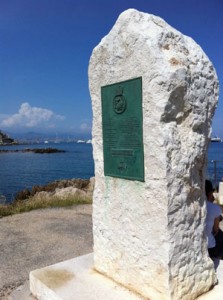
But I stopped to read. It was true! The monument did – it really did – place the adventure of the H.M.S. Unbroken in these waters that lapped against the shores of our Bellevue! To express my true joy – after all the wintertime research – that this thrilling mission was in some way linked to the story of our home would’ve made me a freak. So I bottled it and took a picture instead.
Next thing, I rode up Avenue Foch, the trunk road out of Antibes that I’d driven and ridden and walked more than a hundred times before. I headed to the third corner on the right, as Peter Churchill had so carefully identified in his book. Would I really find Dr Elie Lévy’s house, a covert headquarters of the Résistance?
Among the modern condo blocks that lined Avenue Foch were two older buildings with signs posted to their exterior walls: Mr Lefebvre, architecte, Antibes, 1933. Churchill and his mates would’ve walked right past them, I thought. And then there, at the corner of the third block, mounted on the façade above what’s now an interior design and lighting shop, was a marble plaque: Here lived Dr. Elie Victor Amedee Lévy, Captain; arrested May 4, 1942; died in deportation to Auschwitz; hero and martyr of the Résistance; died for France.
The story was real.

Shortly thereafter, I hopped on my bike again to check out 10, Boulevard du Cap. During the war this address was a place to avoid – a hotbed of the Résistance, rented out by one André Girard, even if people didn’t generally know his name.
There was no number 10 mounted along Boulevard du Cap. And there was hardly a commemorative plaque. But I’m sure I found that infamous block of apartments as it was the only building between numbers 8 and 12. Interestingly though completely disconnectedly, the building is situated at the corner of Avenue du Bosquet. A center of Antibes’ wartime Résistance had been positioned just over the fence from the villa named Le Bosquet, the home of Edouard Muterse, the man who built Bellevue.
I want to take a photo of the place, but I hesitated. Just up the walkway there was a wooden balcony with draped rope railings. Two sinewy guys with long hair were lazing up there, having a smoke. It was exactly as I’d pictured Mr Girard with his own buddies, planning their next move.
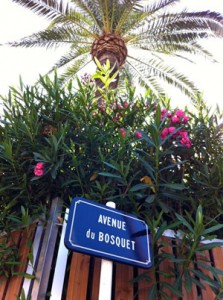
All summer long, Antibes has been revealing herself to me on these two levels, present and past. This latter level is deeper from the surface, but it’s there, only appearing to those who look for it – and know to look for it.
At Antibes’ bus station at the edge of Old Town, Avenue du 24 Août commemorates Antibes’ libération from the occupying forces in 1944. The road – at least from what I’ve read – seems to trace the path of the US soldiers as they approached from Cannes that day. What’s more, Avenue du 24 Août leads directly into Café Pimm’s, the exact spot where (under a different name) the Résistance had congregated in wartime. That morning, 68 years ago almost to this day, a band of armed résistants had marched from that café up Old Town’s central artery, Rue de la République, singing La Marseillaise. It was the day of Libération. They would’ve passed through the plaza that’s now called Place des Martyrs (the one I’ve always referred to – almost blasphemously now – as Place du Carrousel for the merry-go-round that typically occupies our attention), all the way to la mairie, where they demanded – and received – their hand at the local government.
My stitching together of these facts admittedly could be a bit dodgy – I’m hardly writing a doctoral thesis here – but from all my wintertime reading, I’m sure that most of the story is correct.
Over in neighbouring Juan-les-Pins, Boulevard Edouard Baudoin remembers the man who made the place a famous party town back in the 1920s and 30s. Aptly, the boulevard links the town’s casino with the Hôtel Provençal, party headquarters back in its heyday.
On the Cap d’Antibes, Avenue Aimé Bourreau, named for Antibes’ own hyperactive mayor from the 1930s, intersects Avenue Guide, which carries the name of the family who held much of the land on the Cap on which the mayor built.
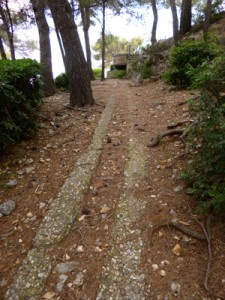
The Guides, incidentally, were the ancestors of Edouard Muterse, Bellevue’s originator. There’s a whole section of Antibes that contains streets linked to his history – Chemin de St-Jean, Avenue Reibaud, Passage Cauvi and, of course, Avenue Muterse. There’s another area of town – just around the corner from the apartment rented out to the résistant André Girard – that’s all about this notable family, too, where you find Avenue du Bosquet and Chemin de Guérande. But to explain all these nuances and connections would make me a real bore.
And one day this summer when I managed to peel my eyes from all the plaques and street signs, I found bunkers from World War II – and earlier – on the shores of the glamourous Cap d’Antibes. I simply had to know where to look for them.
It should be said that sometimes all these signs can lead you astray, like this one on a disused door under an arch in Old Town Antibes: Watch out! Trapped local.
I’ll stop. These “discoveries” might be interesting only to me. Or perhaps it’s the route of discovery – that “ah-ha!” moment – that makes the connections so intriguing. What I mustn’t become is a history drone when unsuspecting friends show a whiff of interest.
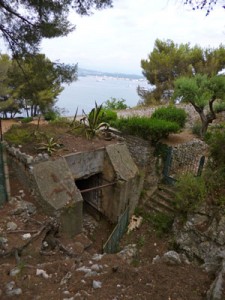
As I read on the bench at the tip of l’Ilette peninsula, the mustiness of the yellowed pages filtered into the sea air. The breeze united with my sweat to form a glorious, personal air-conditioning. I still considered the umbrellas and drinks at the Royal Beach restaurant below, but soon I sank into this realm of 70 years past. Yes, as I read the events anew in English, I confirmed that I’d understood the story the first time in French.
But, though the big picture had remained clear, I’d forgotten the detail. It was hardly a matter of language; the truth is, I’d simply forgotten. Like the fact that on that dark night in April 1942, two bicycles had popped up in the street out of nowhere. Policemen doing their rounds. Churchill and his colleagues Mattheu and Julien had hidden automatically.
And while I remembered Churchill’s encounter on the peninsula with Dr Lévy, I’d forgotten the tangential way in which it began. That night, as the small group huddled in the darkness of their clandestine mission, Lévy launched a question for Churchill – before he even bothered to introduce the diplomat who loitered alongside them. Where, the doctor wondered, were the faked baptismal certificates for his two daughters? Churchill had promised the papers so that Lévy, a Jew, could avoid having his house (purchased in his daughters’ names) confiscated by the Germans.
I’d forgotten, too, that this expedition helped Churchill get a promotion. But I did remember all these details now, as I read them again in the blazing sun.

There was a new tidbit that I pulled from the English text, too, quite probably because the Musée de la Resistance’s website had omitted the detail altogether. The success of this particular mission had rested on fundamental knowledge that Churchill had amassed in his earlier years. It was then that he’d lain on Antibes’ sandy beaches. His parents, the British secret agent reflected, had unwittingly financed this segment of his career.
I wondered anew, given our family’s consecutive summers in Antibes, what we were launching in our own seven-year old’s journey.
By then I was officially boiling. My face burned and my water bottle was almost dry. I’d read more later, I told myself – and elsewhere, in conditions where I could actually absorb the information. I hopped on my bike and headed back toward the road – but my retreat was too hasty. Having just sped by the stone monument to the H.M.S. Unbroken’s expedition, I circled back to re-read the green plaque. It was written in both English and French, but as is the case with so many translations, the two halves gave different information.
The monument remembered the landing of the H.M.S. Unbroken submarine, under Captain Peter Churchill, on April 21, 1942 – and commemorated all those who took part in such landing operations.
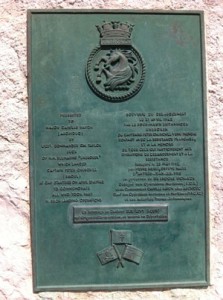
It was presented to Major Camille Rayon (a major Résistance player back in the day) by Lieutenant-Commander C.W. Buck Taylor (who drove the submarine that night) on May 23, 1992.
The last line then caught my eye. It spanned the centerline of the plaque, occupying both the English and French sides, and actually protruded from the face of the stone:
En hommage au Docteur ELIE LEVY (LOUIS)
qui dirigea cette operation, et mourut en Déportation
In tribute to Dr Elie Lévy, code name Louis, who directed this operation and died in deportation.
I had learned the story of the H.M.S. Unbroken through the eyes of Peter Churchill, a British secret service agent. But local history – the collective memory of the people who live here in Antibes– comes through a different lens. To them, the mission was directed by Dr Elie Lévy, an Antibois. He was one of their own. To them, it was Lévy who was the heart of the mission, not Churchill.
History buff or not (and I’ll argue not), I’ll never really get French history. We write our own texts, from the perspectives we know. Still the alternative angles are worthwhile. It is precisely the stories and different voices that keep history alive.
There’s a whole other world here in the Côte d’Azur. It lives invisibly alongside the sandy beaches and sunny cafés. And it’s breathing, shallowly, for those who stop and linger.

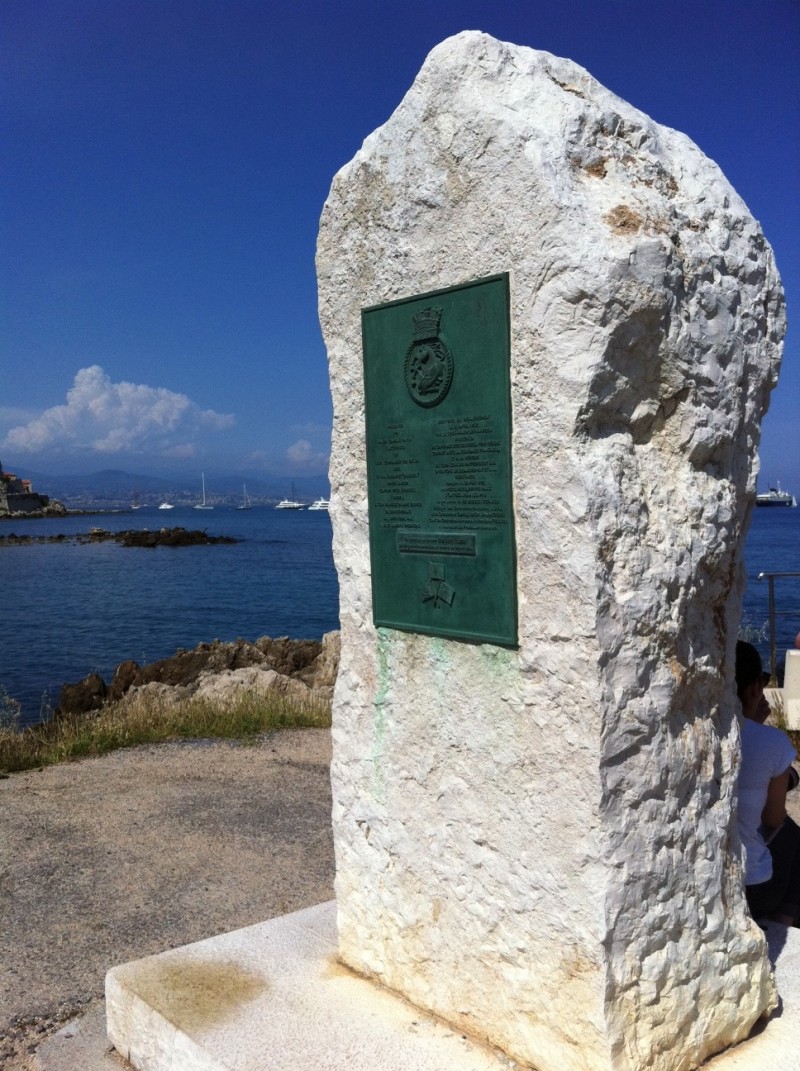
Dear friends,
Delighted to read this entry. My late father, Paul Thirsk, was the navigator aboard HMS Unbroken, and after a holiday I took to the South of France circa 1987, he was looking through my holiday snaps and suddenly stopped at one. “Isn’t that Antibes?” he said. I asked him how the devil he knew that, given that as far as I knew he hadn’t been there (at least in my lifetime). “Oh,” he said “we landed an agent there once during the war – had to take him right in and make sure he got ashore, so we surfaced at night right in the middle of the bay.”
I don’t think Dad ever saw the memorial, but I recall a friend of his once told him they’d chanced upon it on holiday. I’m sure he’d love to have read your kind article. If you ever read Alastair Mars’ book “Unbroken”, there’s a passage where it says something like: “Peter Churchill summed up Thirsk admirably when he said: ‘He’s the kind of man you’d like your sister to marry’…” – and I’ve always thought this was a rather lovely compliment.
God bless them all.
Christopher Thirsk
Dear Christopher,
Reading this note from you is absolutely thrilling! (Please don’t let the intervening weeks between your post and my reply indicate my interest level. It’s off-season right now, so I don’t follow my Côte d’Azur life when we’re not in that sun-drenched land!)
Thank you so much for taking time to write and for sharing these words. You help bring this story to life in yet another dimension – and that’s exactly what I’d set out to do in the first place. Your insights are a true gift.
With gratitude,
Jemma
Thank yu for your article.like you I am totally interested and have read the three books. We are in antibe right now for our fifth visit .our son works here as a yacht captain.all of the facts are absolutely facinating.read more of lise she was odette a most famous and heroic figure.thank you again for your input. By the way where was bellevue I havnt located it yet
Bonjour, Kevin, et bienvenue à Antibes! It sounds as though you’ve been spending a fair bit of time at Port Vauban. It’s lovely to have you as a French Lessons reader, and yes, there is this second layer to the sun-loving town that reveals itself once you begin to look. I’ll begin posting my 2016 edition of this blog in several weeks, so do subscribe and the posts will follow you all summer long, whether you’re still in Antibes or back home. Jemma
Dear Jemma – belated thanks for your very kinds words. It just occurred to me that on April 21st 2017 it will be 75 years since the operation referred to on the plaque. Do you happen to know if there is to be any commemoration of any sort? Do hope you’re having a lovely summer.
Best wishes,
Christopher Thirsk
Hello again, Christopher. Thanks so much for pointing out the upcoming anniversary. I’m not yet in France this summer (but will return soon – as will new posts to this blog), so I’ve not heard about any celebrations. I’ll keep my ear to the ground! Best wishes for the summer back to you, too. Jemma
Just been to Antibes today and read your article . Brilliant writing
Thanks, Alan! Really appreciate hearing from you.
Dear all,
Further to previous posts, please note there will be a commemoration on 21st April 2017 at 10:00am of the 75th anniversary of the Combined SOE / Resistance operation landed by HMS Unbroken in Antibes on 21 April 1942. This will be attended by the Mairie d’Antibes, the British Legion, the Submarine Service, family of those who took part in the operation plus local representatives and relatives of the local Resistance, including those of Major Camille Rayon. Please feel free to come along – all welcome.
Christopher Thirsk
Thanks for the notice, Christopher. What a wonderful gathering. How I wish I could join you all! – Jemma
Thank you for sharing this information. I will be sure to pass it along on my social media platforms. I’m so sorry I will miss this moment by two weeks but will spend some moments of remembrance there in May. What a wonderful coincidence that you discovered Jemma’s fine post on this time in history.
Jemma, I’m so glad you reminded me of this post today. Revisiting it has brought to life many important details of those dreadful years in Antibes (in this particular instance) and the bravery of so many. I will walk in your shoes there after my arrival in May. I encourage you to publish your findings so others may become aware of these details … to be all the more etched in our memories through your fine writing.
Merci, as ever, Patricia, for your encouragement. The personal connections here do somehow make the historical stories even more real. And thanks for using your networks to spread the word. xoj
Hi Jemma, what magic the internet brings us. I have found your post and indeed I know that plaque near Royal Beach. I have passed your blog post onto Archiduc Camille Rayon’s son David who is in the yachting industry in Antibes as I’m sure he’ll be interested to read about your research just prior to the 75th anniversary. Thank you for following this little trail of history! Rebecca
Wonderful! And thank you, Rebecca, for sharing the piece as you have. Jemma
Hi Jemma .kevin back in Antibes .Missed the ceremony 21april however i see the wreaths at the memorial and have paid a visit there today. I also notice that the square at the boules court nearby is fittingly dedicated to dr Elie Levy,i find that most appropriate as he must have played there with his friends. Rgds kevin from australia
Dear Christopher Thirsk I look forward to meeting you on the 21st of April for the 75th anniversary at the ceremony for HMS Unbroken presented to Commandant Achiduc Camille Rayon.
Hello! Just read this and loved it. Curious, though, where did you find those bunkers ? I’ve been quite a lot to antibes and surrounding areas looking for historical/war related remnants – id love to find these !nive heard some properties on the cap still have bunkers on their land though in sure many have been built over!
Thanks
Emma
Bonjour, Emma! The bunkers in the photos are situated on the property that was the Musée Napoléonien in years past, right toward the end of the Cap d’Antibes beside the Hôtel du Cap. The museum was closed a couple years ago, but I believe the area remains public and is known as Espace Mer et Littoral – Batterie du Graillon. It’s worth a try heading over there. I, too, have read about private properties on the Cap having remnants of the War but haven’t seen any personally. Happy hunting!
Wish I had discovered this blog before I went to Antibes last week as I am reading up on the SOE
& Resistance in France. Instead I had to go to Picasso’s house. I did manage a swim on the beach.
Dear Don, your comment made me laugh out loud. I hope Picasso’s house wasn’t too much of a letdown! 😀 But you now have found this blog, and there are a handful of historical posts on it, so we’re glad to have connected. Merci for posting this comment.
Dear Jemma,
Thank you for this fascinating blog post. I love to get drawn into local history and find out untold stories. We are on holiday in Antibes this week and I will look out for the locations and other sources in your post. I write walking guidebooks and also historical fiction and I can never help being drawn into certain stories.
Merci,
Bonjour, Deirdre, and what pleasure to read this comment! It’s a joy to connect with another person interested in Antibes and its stories and to somehow accompany your days here. I wish you a beautiful stay.
‘Let’s go and see Sting this summer at the Theatre Antique d’Orange,’ announces my daughter from LA. Ok, I say. Let’s turn it into a little expedition. So we’re flying to Nice and staying in an Air not far from the Old Town in Antibes for four nights. Now, being a retired History, English and Sports teacher, I couldn’t resist digging into the local WW2 history. Bring on the Killing Fields of Provence by James Bourhill in which of course Peter Churchill gets a mention. I hadn’t quite realised the scale of the US landings in August 1944 and the ferocity of the opposition. And then I come across your blog with the picture of the memorial. This follows on from my binge reading of most the well known books about SOE and the remarkable work of Sarah Helm. ‘Prepare for plenty of plaque reading’, I said to my daughter. Luckily she is into History as well, I taught her once in Year 5 (!) and she studied at King’s in London. And then there’s the great pillbox hunt… Love your blog – it really adds another dimension to our upcoming stay in Antibes!
Hi Gareth,
Better late than never on the reply, right? Thank you so much for sharing this message, and I remember exactly when you were in the area because I would’ve loved to be at that Sting concert myself! Living in Antibes – all the plaque reading, as you say – certainly brings history to life and can make it palatable to even the history loathers. I’m pleased to have brought this little corner of the world to life in this way.
Musically yours, jemma
Dear Jemma,
I am sure I read and loved this article when it was first written but I just re-read it and it is so good! I am really happy that you keep all your articles so that we can re-visit them.
I hope our paths will cross again somewhere.
Merci, gros merci, Kristina, for being such a devoted reader of this blog – and a researcher in your own right of this fêted area! It’s lovely to see your name cross my screen, and yes, I look forward to our paths crossing in the future. xoj